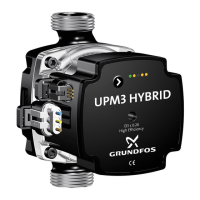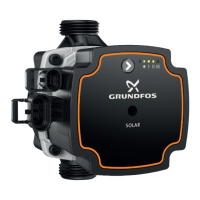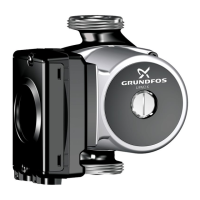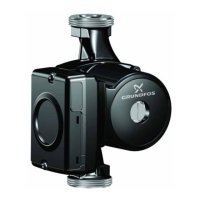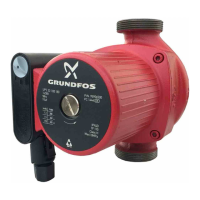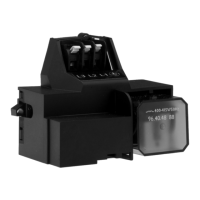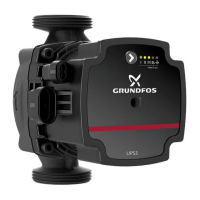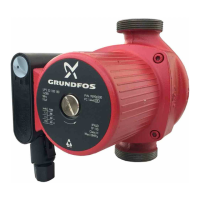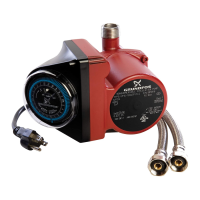Recommended pump type according to application
Application Recommended type
Heat production or heat transmission side
Gas- or oil-fired space and combination heaters UPM3, UPM3 LIN, UPM3 FLEX AS
Solid fuel heaters UPM3 FLEX AS, UPM3 AUTO
Heat pumps (brine side) UPM3(K), UPM3 LIN, UPM3(K) FLEX AS
Heat pumps (heating side) UPM3, UPM3 LIN, UPM3 FLEX AS
Mini combined heat and power cogeneration UPM3, UPM3 LIN, UPM3 FLEX AS
Thermal solar system (collector side) UPM3(K) SOLAR
District heating systems with heat exchanger UPM3 FLEX AS, UPM3 AUTO
Heat distribution side
Space heating systems UPM3 AUTO, UPM3 HYBRID
Space heating and cooling systems UPM3(K) AUTO, UPM3(K) HYBRID
Domestic hot water generation (heating side) UPM3 FLEX AS
Domestic hot water generation (DW side) UPM3(K) DHW
Domestic hot water recirculation UPM3 DHW
Gas- or oil-fired space and
combination heaters
Most of the installed systems for space and water heating
in building services are still using fossil fuels such as
natural gas or mineral oil, although the use of gas and
liquid fuels out of biomass is increasing. Heaters with
higher water content, such as floor-standing boilers, are
heated independent of the actual flow. Heaters as wall-
mounted boilers are only fired when there is a minimum
flow through the primary heat exchanger. In a combi-
boiler, the pump supplies both the heating system and the
hot water supply.
More and more of these heaters are condensing boilers
temperature-controlled by a weather-compensating
system controller with different time programs, which
means the central heating water temperature is often
lower than the domestic hot water temperature. In
systems with domestic hot water supply either as
combination heaters with integrated DHW supply or with
external DHW tank or heat exchanger there is a need to
increase the medium temperature temporarily above
DHW temperature level. In small residential buildings, the
heating demand for DHW is higher than for space heating.
Internal (or external) pumps for these primary circuits
must be controlled by the needs of the heaters to optimise
the combustion conditions and the condensation process.
Often this can only be guaranteed by using a variable-
speed pump with external control signal from the boiler
controller.
Solid fuel heaters
As most of these heaters use wood biomass such as
pellets, split logs or wood chips, they can be seen as
renewable energy and CO
2
neutral. These heaters are
mostly reacting slowly on different heat demands. For this
reason, the liquid temperature might increase and there is
a need for keeping the flow constant and for storing the
energy in a buffer tank.
Heat pumps
Different types of heat pumps are on the market:
• Compressor heat pumps with electric or combustion
motors
• Sorption heat pumps. Sorption is a physical-chemical
process where either a liquid or a gas is absorbed by
another liquid (absorption) or is retained by the
surface of a solid object (adsorption). Both processes
are reversible and only occur under certain conditions
through physical effects (pressure, temperature).
Often a pump with customised specification is
installed inside such a process unit.
Primary pumps are depending on the heat transmission
principle:
• Air-to-air heat pumps are often used in air-
conditioning systems
No pump is used.
• Air-to-water heat pumps for space heating and
cooling or water heating
The heat source is mainly outdoor air down to an outside
temperature of minus 20 °C. Its energy is mainly extracted
directly by a fan-supplied air evaporator of the heat pump.
Sometimes there is a primary brine circuit between an
outdoor air unit and a brine-to-water heat pump. This
circuit is circulated by a pump that must stand liquid
temperatures down to minus 20 °C.
• Water-to-water heat pumps for space heating and
cooling or water heating
The energy source can be groundwater between 7 and 12
°C. Groundwater is extracted mainly via a submersible
pump in a supply well and returned via a return well. If its
water quality is not guaranteed, there is a primary circuit
between a heat exchanger and the heat pump. This circuit
is circulated by a pump that must stand liquid
temperatures down to plus 2 °C.
• Brine-to-water heat pumps for space heating and
cooling or water heating
Horizontal ground collectors or probes set vertically into
the ground deliver the ground-stored solar energy via a
mixture of water and antifreeze (brine) to the evaporator
of the heat pump. This circuit is circulated by a pump that
UPM3
3
7
Applications

